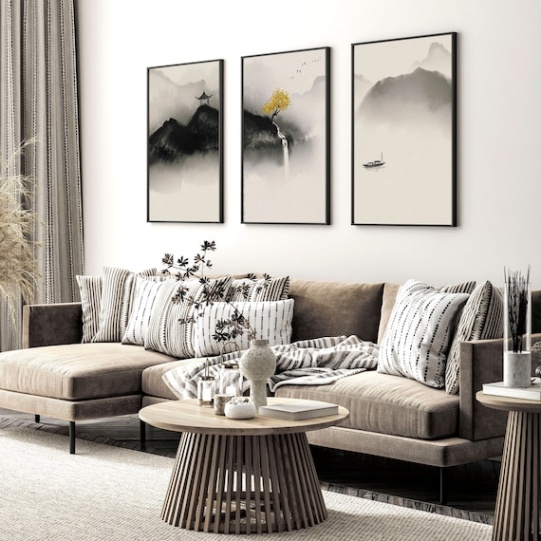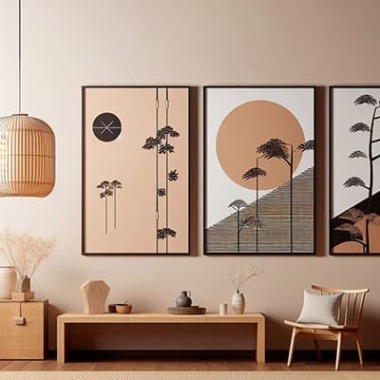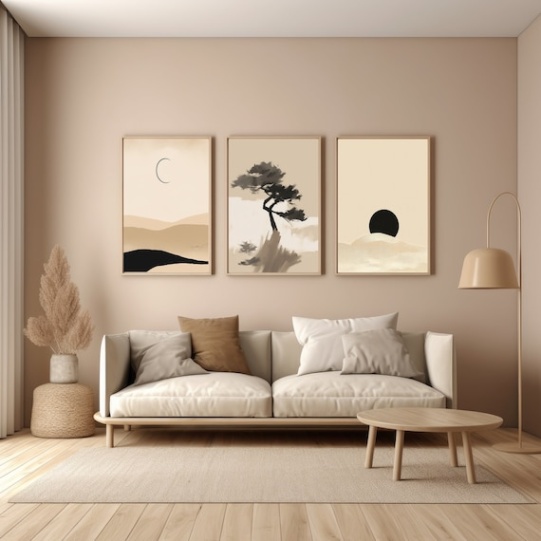1. Wabi-Sabi Wall Hangings

Image Source: etsystatic.com
In the heart of the Japandi aesthetic lies the philosophy of Wabi-Sabi, an embrace of imperfection, transience, and simplicity. Wabi-Sabi wall hangings capture this essence, transforming ordinary objects into extraordinary pieces of art.
What are Wabi-Sabi Wall Hangings?

Image Source: bumblejax.com
Wabi-Sabi wall hangings are often handcrafted items that celebrate natural imperfections. They can range from simple, dried plant materials to intricately woven textiles. The key is to find pieces that resonate with you and evoke a sense of calm and tranquility.
How to Incorporate Wabi-Sabi Wall Hangings into Your Space:

Image Source: etsystatic.com
1. Natural Elements:
2. Textiles:
3. Calligraphy:
Styling Tips:
Balance and Asymmetry: Balance the simplicity of Wabi-Sabi with a touch of asymmetry. For example, hang a symmetrical piece of calligraphy next to an asymmetrical arrangement of dried flowers.
Creating Your Own Wabi-Sabi Wall Hanging:
If you’re feeling creative, you can create your own Wabi-Sabi wall hanging. Here are a few ideas:
Pressed Flower Art: Press your favorite flowers and arrange them in a frame.
By incorporating Wabi-Sabi wall hangings into your space, you can create a serene and stylish atmosphere. Remember, the beauty of Wabi-Sabi lies in its simplicity and imperfection. So don’t be afraid to embrace the beauty of the imperfect.
Note: Please provide the list of items you’d like me to focus on. Once you share the list, I can tailor the article to the specific item and its relevance to the theme.
Here’s a hypothetical example, assuming the second item on your list is “Ikebana”.
Ikebana: A Floral Symphony on Your Wall
Ikebana, the ancient Japanese art of flower arrangement, is more than just a decorative practice. It’s a philosophy, a language of nature expressed through form and space. By understanding the principles of Ikebana, you can create stunning wall art that embodies the essence of Japandi design: minimalist yet impactful.
The Philosophy Behind Ikebana
At its core, Ikebana is about balance, harmony, and asymmetry. The arrangement is often composed of three main elements:
Shin (Main Flower): The tallest stem, symbolizing heaven.
These elements are arranged in a way that creates a sense of rhythm and movement. The empty space around the flowers is just as important as the flowers themselves. It’s in this negative space that the true beauty of Ikebana lies.
Ikebana as Wall Art
While Ikebana is traditionally displayed in vases, it can also be adapted into stunning wall art. Here are a few ideas:
1. Pressed Flower Art:
2. Shadow Box Ikebana:
3. Ikebana-Inspired Painting:
Incorporating Ikebana into Your Japandi Decor
To seamlessly integrate Ikebana-inspired wall art into your Japandi decor, consider the following tips:
Minimalist Framing: Choose simple, minimalist frames that complement the natural beauty of your arrangement.
By understanding the philosophy and techniques of Ikebana, you can create stunning wall art that reflects your personal style and brings a touch of nature into your Home.
3. Nature’s Serenity: Botanical Prints
In the heart of the Japandi aesthetic lies a profound appreciation for nature. Botanical prints, with their delicate lines and earthy tones, perfectly capture this essence. They bring the tranquility of the natural world indoors, transforming your walls into serene landscapes.
The Power of Simplicity
Japandi design champions minimalism, and botanical prints embody this philosophy. Their clean lines and understated colors create a sense of calm and order. A single, well-placed botanical print can be a powerful focal point, drawing the eye and elevating the overall ambiance of a room.
A Tapestry of Textures
To add depth and visual interest to your Japandi space, consider incorporating botanical prints with various textures. A smooth, matte print can complement a textured wall, while a textured print can add dimension to a sleek, minimalist space. Experiment with different paper types, such as watercolor paper or linen, to create a unique and personalized look.
Color Palette: Nature’s Hues
Japandi design often employs a muted color palette inspired by nature. Botanical prints, with their earthy tones of green, brown, and beige, seamlessly blend into this aesthetic. However, don’t be afraid to introduce pops of color through vibrant flowers or foliage. A bold, colorful print can be a striking accent piece, adding a touch of personality to your space.
Framing Your Art
The right frame can elevate a botanical print from ordinary to extraordinary. Choose a frame that complements the style of the print and the overall decor of your room. A simple, minimalist frame in a natural wood tone can enhance the natural beauty of the print. For a more contemporary look, consider a sleek, black or white frame.
Styling Tips
By incorporating botanical prints into your Japandi design scheme, you can create a space that is both serene and stylish. Let the beauty of nature inspire your Home decor and transform your walls into a tranquil oasis.
japandi wall art














